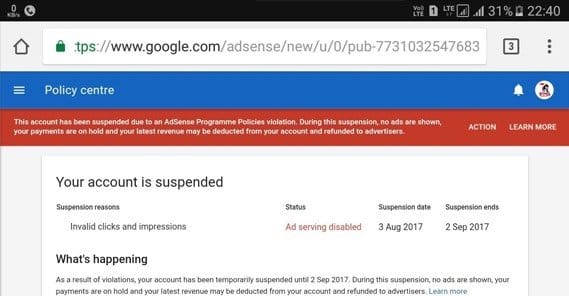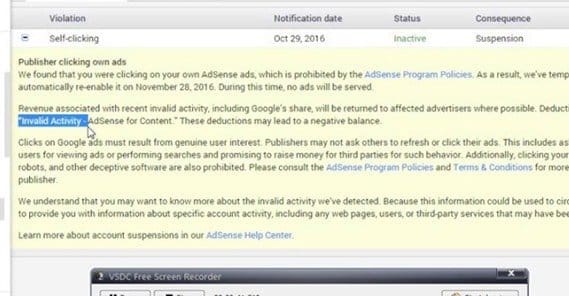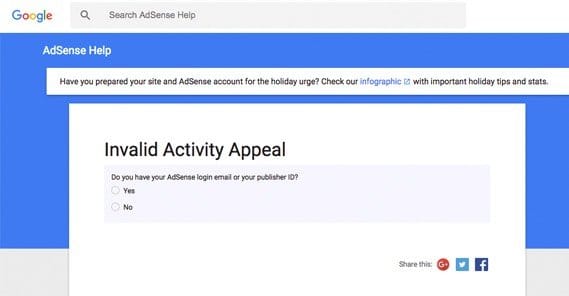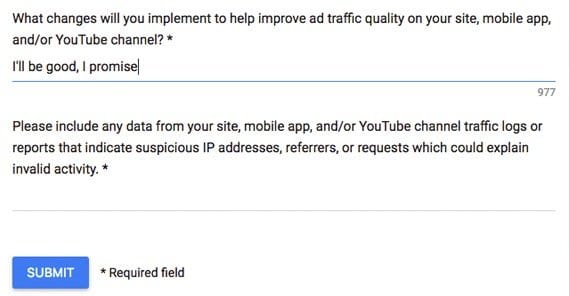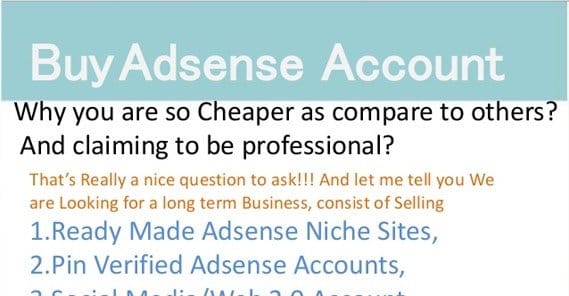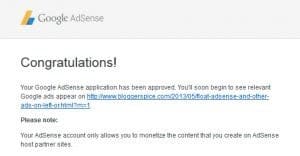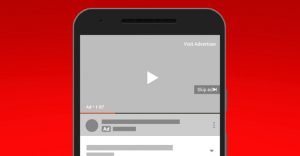How to Get Back on AdSense After Being Suspended

Google’s AdSense is interesting. For one thing, it’s massive; hundreds of thousands of blogs use it to monetize their content, and virtually every YouTube channel that clicks the “monetize this video” button is doing it through AdSense.
This massive monopoly over marketing channels means that Google can be very fickle with their rules. Time and again, you’ll see people skirting the rules and getting away with it for months or years. Yet when you try to do the same thing, you’re suspended almost immediately.
It’s even worse when you consider that you can be banned for actions outside of your control. Your site gets hacked and you can be banned. Someone sends some fraudulent clicks your way and you can be banned. Sometimes you can be suspended for something you don’t even realize you did, or that you did years ago and was only now considered bad enough to warrant the ban. There are stories all over of people who were banned for fraudulent clicks years ago, with perfect advertising since.
At least, that’s what the marketers claim. You never know how much of a story to believe, do you? Spend any amount of time on a black hat forum and you’ll soon recognize that people will frequently lie for their own benefit, especially to authority. It’s the same way griefers in video games complain that they were doing nothing wrong, Like this guy, who claims he was suspended for a few basic reports, but actually had thousands of complaints of violations. Obviously, anyone who knows they were breaking the rules is going to try to downplay their violation in order to be reinstated.
This is all compounded by the fact that an AdSense ban is a lifetime ban. This guy was banned a decade ago, and has no chance of appeal. That’s the kicker, right? Once you have violated Google’s trust in a way that jeopardizes their financial relationships, you’re done and dusted.
It really is all about the money. With organic SEO, violating rules will get you penalized or de-indexed, but fixing those mistakes will often return you to where you were. You may have lost a little trust in doing so, making future mistakes more costly, but it’s always fixable. It takes a LOT to be permanently removed from the search index, and by “a lot,” I mean blatant theft of personal information, distributing malware, doing something incredibly illegal, or refusing to fix your black hat exploits.
With AdSense, fraudulent activity hurts Google quite a bit. The more fraudulent activity passing through their network, the more advertisers lose faith in the platform. As advertisers lose faith, they’re less willing to pay higher prices for advertising space. Once bitten, twice shy, after all. If problems persist, advertisers will jump ship, which means Google loses their revenue streams.
It’s a lot easier for Google to ban people with a zero tolerance policy than it is to keep giving second chances. The amount of abuse that would come from a second chance is simply too high. It’s not a risk they’re willing to take.
You Were Banned: What Now?
Say you’ve made a mistake and you’ve been banned from AdSense. You probably got an email saying something like “It has come to our attention that invalid clicks have been generated on the Google ads on your sites. We have therefore disabled your Google AdSense account. […] Publishers disabled for invalid click activity are not allowed further participation in AdSense and do not receive any further payment. The earnings on your account will be properly returned to the affected advertisers.”
This means a few things. First of all, invalid clicks were detected on your account and Google banned you for it. Secondly, any earnings you had are returned to the advertisers whose traffic was found to be fake. Any other earnings you may have gotten legitimately are either returned to the advertiser or just seized by Google themselves. Once you’re banned, no matter how much money you had pending payment, you’re not seeing another dime.
I’m going to say one thing right up front. If you were at fault for the invalid activity – such as clicking the ads yourself or paying for clicks in a traceable way – you’re not getting your account back. Google doesn’t want you on their platform. There are no three strikes; it’s one strike and you’re out.
If you want your account to be reinstated, you absolutely must not be at fault. You have one single chance at an appeal for invalid click activity, and that’s it. If you fail this appeal, you will never get that account reinstated.
Google knows how important this one appeal is to people, so they even published a post on their official blog in 2016 giving tips on how to write an appeal. Here’s a summary of what they have to say.
First of all, know the difference between a suspension and a disabled account. If your account is suspended, it’s a temporary ban used as a warning for you to get your shit together and stop breaking the rules. Suspensions typically last 30 days – enough to cripple a small blog or serve as a warning for a large one – and cannot be appealed. You can fill out a form to get further information on why you were suspended – this form here – but you can’t appeal the suspension.
A disabled account is a permanently banned account with one potential appeal and that’s it. Your account can be disabled for a number of reasons, but the most common and worst to recover from is invalid activity.
The appeal form for invalid activity is here.
- Step one is to learn why invalid activity happens. Google has a rundown on the common causes in this help page. Think about which of them might apply to your site, and if they involve behavior you can prevent in the future.
- Step two is to review the user flow on your site and look for times where a user might accidentally click on an ad. For example, if your mobile site has a “next page” link very close to an AdSense ad link, “fat fingering” the wrong link would count as potentially invalid click activity.
- Step three is to compose your appeal.
Composing an appeal is very important and will make or break your chances to be reinstated. First of all, make sure you’re entirely honest, with yourself and with Google. If you did something wrong, don’t try to downplay it, shift blame, or profess ignorance. The less sincere you are, the less likely Google is to let you back in. After all, if you don’t know where the invalid click activity came from, you can’t prevent it from happening again.
In your appeal, make sure to give Google an honest look at what you did wrong, why you now know it’s wrong, and the steps you have taken to prevent it from happening again. You have expressly told your friends not to click the ads repeatedly. You’ve moved ad placement to prevent accidental clicks. You’ve removed interstitials that violate ad policies. You’ve ceased buying traffic from a source that led to fraudulent activity.
Make sure all the information you provide – your name, email address, and so forth – are the same as the information in the AdSense profile you’re looking to recover. If your email address is incorrect, or there’s another discrepancy in the information, not only can it jeopardize another account you might want to make with that information should your appeal be denied, it takes Google more time to find the right account and examine the reason it was banned.
When writing your appeal, avoid too-casual language, avoid being angry or threatening abuse against Google or its employees, and NEVER threaten legal action. Abusive emails put the employee in charge of reviews in a bad mood and makes them a lot more likely to deny your appeal. A threat of legal action will simply be forwarded to their legal team to await your legal challenge, and your appeal will never be approved. Unless you’re legitimately prepared to take Google to court, don’t even think of mentioning legal action.
If you have identified a PPC traffic source or other paid source of traffic that led to invalid activity, offer to cooperate with Google to investigate that traffic source with them. Provide evidence that those clicks were not intended behavior if possible. For example, if you ran Facebook ads to your site with the objective of getting traffic to a landing page, but the traffic you got proved to be invalid activity, you should be able to prove you weren’t trying to get those clicks to your ads. You want to profess the idea that “if I can help you investigate my account, let me know what information I can provide.” The more cooperative you are, the better your chances of seeing a successful appeal.
Submit the appeal and wait. If you haven’t received a reply within two weeks, send them a follow-up email. Be patient; there are thousands of people looking to appeal, and an investigation can take some time.
If your appeal is accepted, congratulations! You have your account back. Now all you need to do is do everything in your power to avoid future invalid click activity.
Appeal Denied: Now What?
If your appeal is denied, you can generally kiss that particular AdSense account goodbye forever.
I’ve seen some rare instances where an account that was banned years ago is reinstated unexpectedly, with no appeal and no activity. If that were to happen, you absolutely would have needed the right confluence of factors. Number one is to never try to make another account that could get tied into your first one, since circumventing a ban just puts you on their shit list. Number two is to be on the borderline of the rules in the first place, so a slight change to the rules puts you in valid territory, so you didn’t actually do anything wrong.
I wouldn’t count on it, but if you want to bank on an eventual automatic reinstatement of your account, you should abandon AdSense, put it out of your mind, and find some other way to monetize.
You have two general alternatives if your AdSense account is banned and you fail an appeal. The first is to circumvent the ban and try to avoid being caught. The second is to explore another monetization option.
In terms of alternative monetization options, you can look for other forms of display ads from other providers, or you can shift your business model. Affiliate marketing can work quite well in certain niches, as can dropshipping. If your site can’t support alternative monetization strategies, more display ads from another provider can work well enough.
Circumventing your ban means creating a new AdSense account from scratch. I don’t recommend this option, because most people slip up eventually and will be caught, and doing so will jeopardize any future use of Google ads in any capacity. It’s a high risk, low reward venture.
If you’re determined to do it, you need to start from scratch making a new AdSense account. Don’t use any information you have used before. Use a different email address, a different name, a different bank account, a different IP address whenever you access it, and different everything else.
The hardest part here is that often it’s not just your AdSense account that is banned, it’s your website. If the website is blacklisted, you won’t be able to run AdSense on it even if you have a new account that works.
It’s sometimes possible to create a second valid AdSense account by using your business name and a business bank account. This can be perfectly legitimate, assuming you didn’t get a business account banned in the first place, but you’re still at risk if you use the same techniques that banned the first account.
Your final alternative might be paying an advertising agency to handle ads on your site. If your site makes enough money to make this a worthwhile venture, you can give it a try. Otherwise, you’ll probably just be losing money in the deal.
 ContentPowered.com
ContentPowered.com
